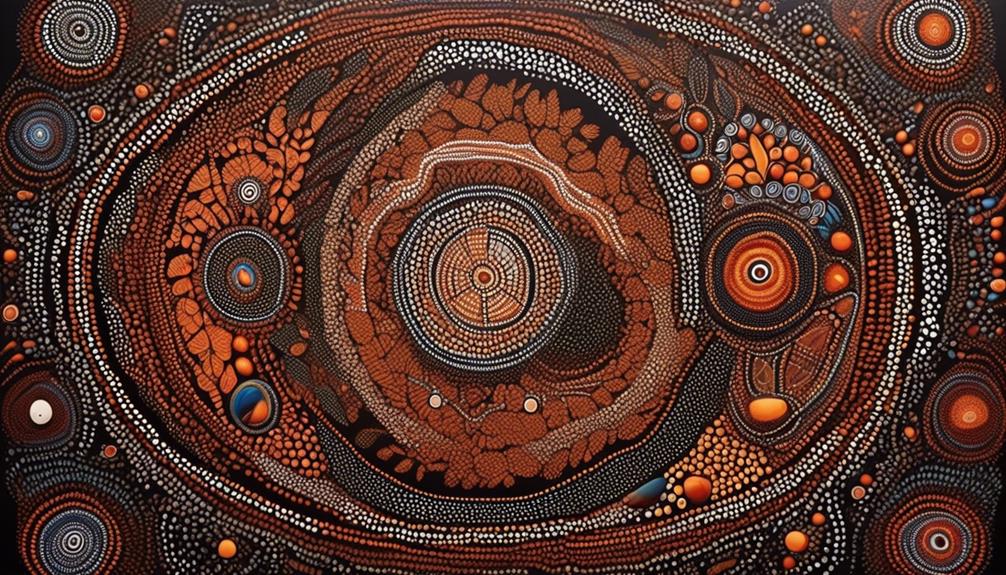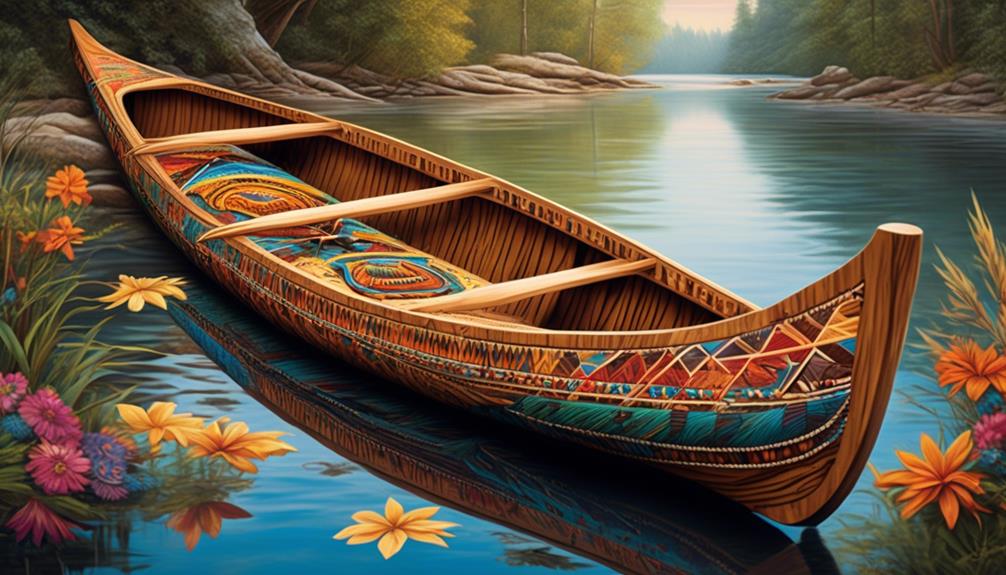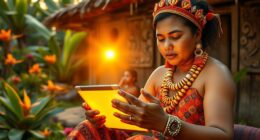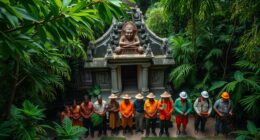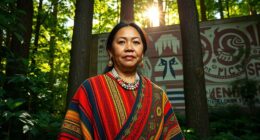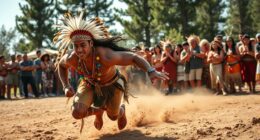As we stand at a pivotal moment in history, the rich culture of the Australian Aboriginal people beckons us to explore its colorful tapestry of traditions, beliefs, and resilience.
The stories of the Dreamtime and the ancestral spirits, the intricate kinship systems, and the vibrant art forms all hold a key to understanding a culture that has withstood the test of time.
However, the true depth of this ancient culture goes far beyond what meets the eye. There is a complex web of knowledge, history, and contributions that have shaped not only the past but also the present and future of Australia.
Key Takeaways
- Australian Aboriginal people have a history dating back over 50,000 years and their ancestors were part of the first successful human migrations out of Africa.
- Dreamtime and Creation Stories are foundational to Aboriginal spirituality and cultural practices, reflecting diverse traditions and explaining the origins of the world and people.
- Dreamtime art plays a crucial role in visualizing and passing down these stories, representing the spiritual connection to the land and ancestors.
- Kinship dynamics structure relationships, roles, and responsibilities within Indigenous Australian communities, influencing marriage, child-rearing practices, resource allocation, and social organization.
Origins and Migration
Through extensive archaeological and genetic research, we've gained valuable insights into the complex origins and migration patterns of Australian Aboriginal people. This research has revealed a rich tapestry of ancestral origins and intricate migratory routes that span thousands of years.
The origins of Australian Aboriginal people can be traced back over 50,000 years, making them one of the oldest continuous cultures in the world. Genetic studies have shown that their ancestors were part of the first successful human migrations out of Africa. These early Aboriginal populations ventured into the harsh and diverse landscapes of Australia, adapting and diversifying as they spread across the continent.
Migration patterns of Australian Aboriginal people were influenced by a variety of factors, including changes in climate, the availability of resources, and cultural interactions. The detailed study of ancient DNA has provided evidence of multiple waves of migration and the mixing of different ancestral groups. These migrations weren't linear but rather complex, with interactions and movements between different regions over time.
It's important to recognize that these migration patterns and ancestral origins are central to the identity and cultural heritage of Australian Aboriginal people. Understanding and respecting these historical narratives is crucial for acknowledging the richness and diversity of their heritage.
Dreamtime and Creation Stories
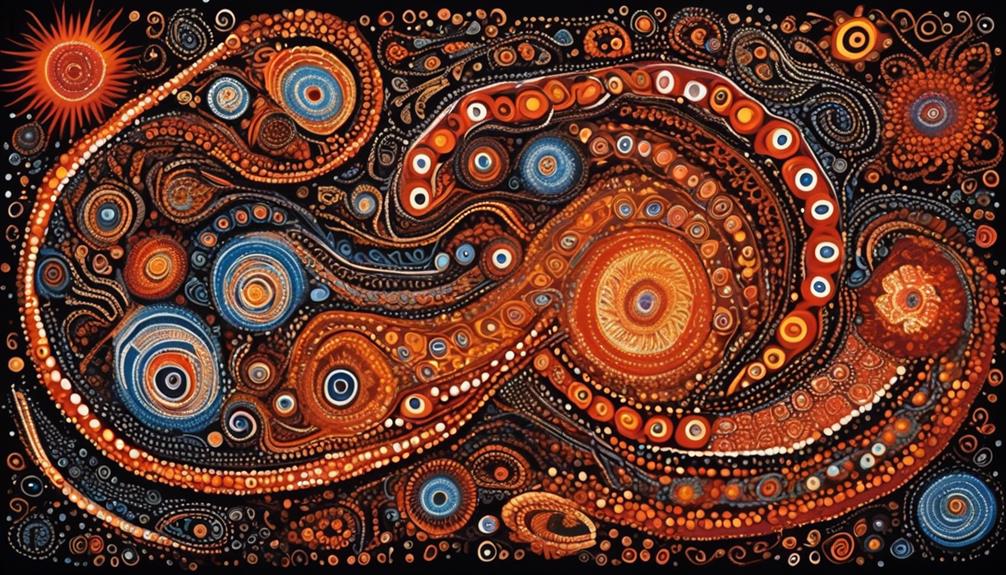
The Dreamtime and Creation Stories hold significant importance in Australian Aboriginal culture, serving as the foundation for spiritual beliefs and cultural practices.
These stories are diverse, reflecting the rich tapestry of Aboriginal traditions and providing insight into the diverse ways in which different Aboriginal groups understand the origins of the world and their place within it.
Understanding the Dreamtime and Creation Stories is crucial to appreciating the depth and complexity of Aboriginal spirituality and the interconnectedness of the natural and spiritual worlds.
Dreamtime Significance
In Australian Aboriginal culture, Dreamtime and Creation Stories hold immense significance, weaving a rich tapestry of spirituality, history, and identity for the indigenous peoples of Australia.
Dreamtime symbolism and storytelling are integral to understanding the Aboriginal worldview. These stories aren't just myths but are the foundation of their beliefs, explaining the origins of the land, animals, and people.
Dreamtime art also plays a crucial role, as it's used to depict and pass down these stories through generations. The symbolism in these artworks often represents the spiritual connection to the land and the ancestors, creating a visual language that communicates the essence of the Dreamtime.
Understanding the Dreamtime significance allows for a deeper appreciation of the Aboriginal culture and its enduring legacy.
Creation Story Diversity
Creation Story Diversity encompasses various Dreamtime and Creation Stories, reflecting the multifaceted cultural heritage and spiritual beliefs of the Australian Aboriginal people.
Storytelling traditions play a central role in the preservation and transmission of these Creation Stories, serving as a means of passing down knowledge, history, and spiritual truths through generations.
The oral nature of these stories ensures that they remain dynamic, adapting to different landscapes and cultural contexts.
Cultural significance is inherent in these Creation Stories, as they're often tied to specific locations, serving as a testament to the deep connection between the Aboriginal people and their land.
These diverse stories also highlight the rich tapestry of beliefs and traditions that exist among different Aboriginal groups, showcasing the depth and complexity of their spiritual and cultural heritage.
Spiritual and Cultural Importance
Reflecting the enduring spiritual and cultural significance of the Australian Aboriginal people, Dreamtime and Creation Stories serve as profound narratives that convey the essence of their rich heritage.
These stories are deeply rooted in the sacred sites and rituals that form the basis of Aboriginal spirituality. They encapsulate the profound connection the Aboriginal people have with the land, carrying the wisdom of their ancestors and shaping their understanding of the world.
The Dreamtime and Creation Stories aren't just myths; they're integral to the Aboriginal way of life, guiding their traditions, customs, and laws. By participating in rituals and ceremonies that honor these stories, the Aboriginal people maintain a spiritual connection to their ancestors and the land.
This spiritual and cultural significance is paramount in understanding and respecting the essence of the Australian Aboriginal people.
Traditional Beliefs and Spirituality
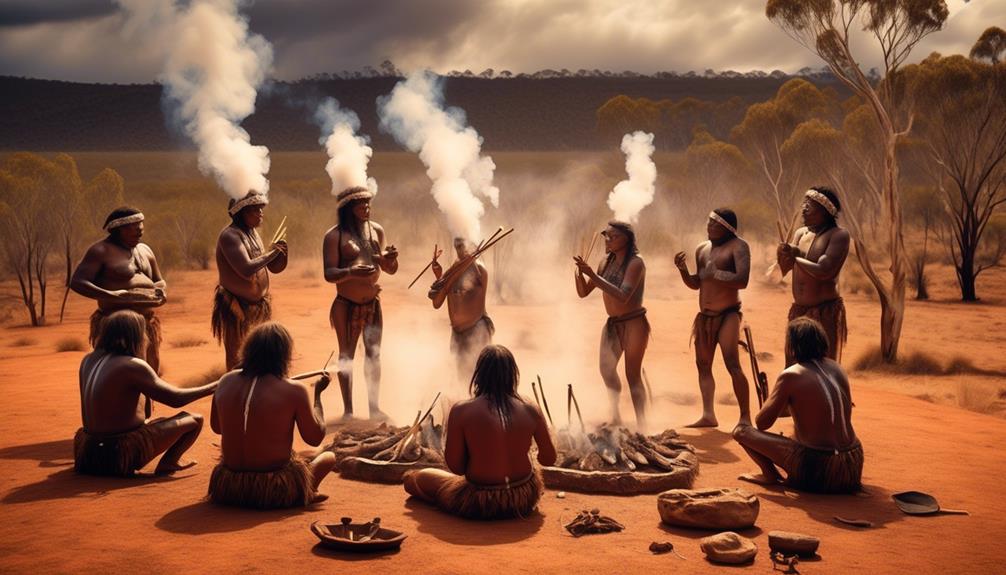
Rooted in a deep connection to the land and the natural world, Australian Aboriginal traditional beliefs and spirituality form an integral part of our cultural identity. Our spirituality is a multifaceted and deeply ingrained aspect of our existence, shaping our worldview and guiding our interactions with the environment and each other.
Beliefs: Our traditional beliefs are centered around the Dreamtime, a period when ancestral spirits created the world. These beliefs are passed down through oral traditions and are integral to our understanding of the world and our place within it.
Rituals and Practices: Our rituals and practices are diverse, ranging from ceremonies that honor the land and ancestral spirits to initiation rites that mark the transition to adulthood. These rituals serve to maintain a harmonious relationship with the natural world and our communities.
Spiritual Connection to Land and Ancestors: The land isn't just a physical space for us; it's a living entity with its own spirit. We believe in our deep spiritual connection to the land and our ancestors, viewing them as custodians of our cultural knowledge and wisdom. This connection informs our stewardship of the land and our respect for our ancestors' teachings.
Our traditional beliefs and spirituality are integral to our cultural heritage, providing us with a sense of belonging and guiding our interactions with the world around us. These beliefs continue to shape our identity and influence our approach to life, emphasizing the interconnectedness of all living things and the importance of preserving our cultural practices for future generations.
Kinship and Social Structure
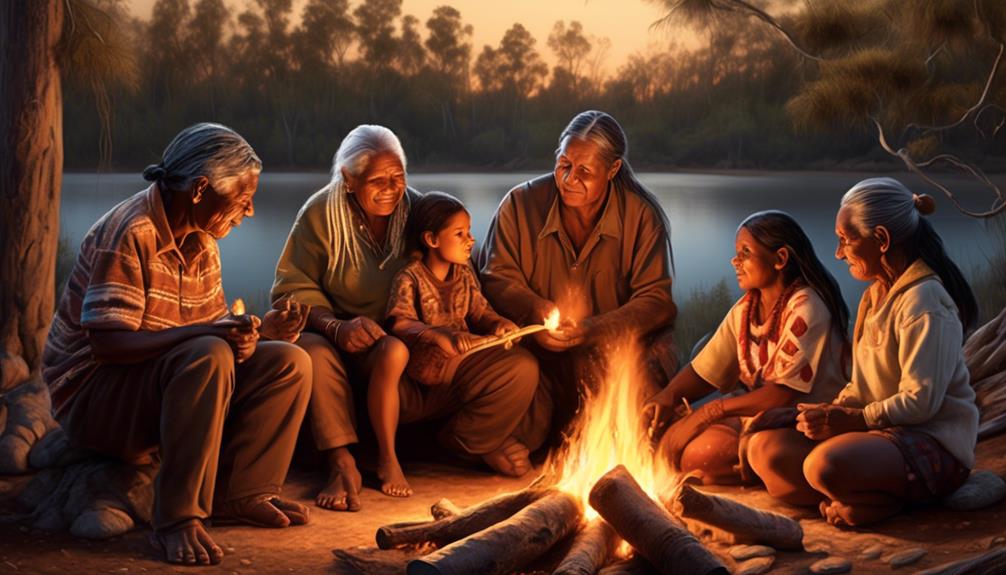
Indigenous Australian communities maintain a complex kinship system that intricately weaves together family connections, social obligations, and cultural responsibilities. Kinship dynamics form the foundation of our community structure, shaping relationships, roles, and responsibilities. Within our communities, traditional roles and societal hierarchies are deeply rooted in kinship systems, guiding social interactions and decision-making processes.
Kinship dynamics play a central role in structuring our communities, influencing everything from marriage and child-rearing practices to resource allocation and social organization. Our kinship system is intricate and multifaceted, encompassing various kinship categories and prescribed behaviors that govern interactions between relatives and community members. These dynamics foster a sense of interconnectedness and mutual obligation, promoting cooperation and unity within the community.
Traditional roles within Indigenous Australian communities are often defined by kinship ties, with specific responsibilities and privileges allocated based on one's kinship status. This hierarchical structure contributes to the social order and functioning of the community, ensuring that individuals uphold their cultural obligations and contribute to the collective well-being. Respect for elders and adherence to traditional protocols are integral aspects of our societal hierarchies, emphasizing the importance of wisdom, experience, and ancestral knowledge in guiding community affairs.
Art and Cultural Expression
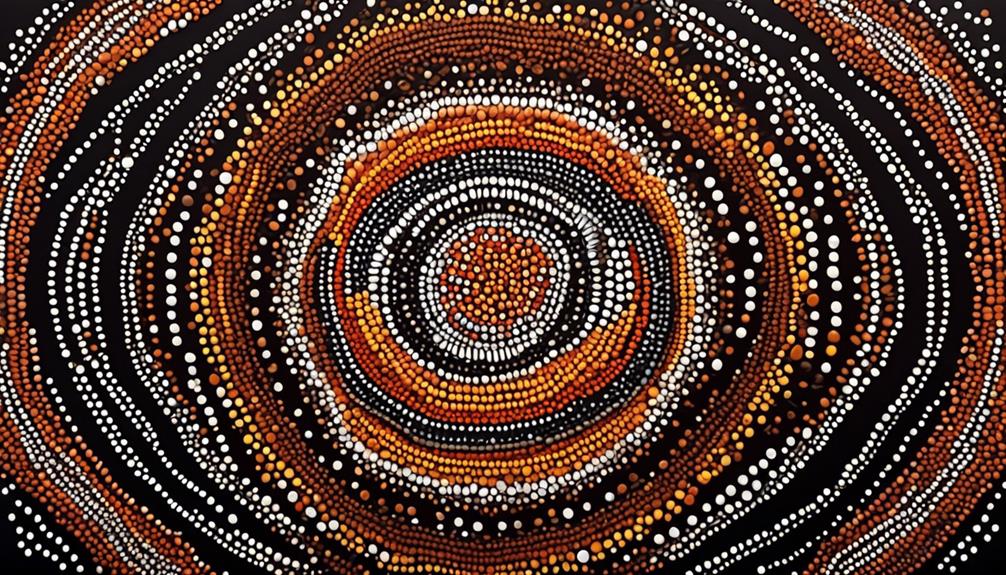
Art and cultural expression hold significant importance within our community, serving as vital forms of storytelling and connection to our heritage and traditions. Through artistic expression, we preserve our cultural identity and communicate Indigenous perspectives to the world. Our art isn't only a means of creative expression, but it also serves as a powerful tool for cultural preservation.
- Artistic Expression: Our artworks, including paintings, carvings, and ceremonial objects, are deeply intertwined with our cultural traditions and spiritual beliefs. These artistic expressions often convey narratives of creation, the land, and ancestral beings, carrying the wisdom and history of our people.
- Cultural Preservation: Our art plays a crucial role in preserving and passing down our cultural heritage to future generations. It encapsulates our values, knowledge, and customs, ensuring that our traditions remain alive and vibrant in the face of modern influences.
- Indigenous Perspectives: Through art, we share Indigenous perspectives on the interconnectedness of all living things, the significance of Dreamtime stories, and the importance of kinship and community. These expressions offer insight into our worldview and foster a deeper understanding of our culture.
As we navigate the complexities of the modern world, our art continues to evolve, incorporating contemporary influences while staying true to our roots. This dynamic blend of tradition and innovation allows us to express our cultural resilience and adaptability, ensuring that the essence of our heritage endures.
Survival and Adaptation
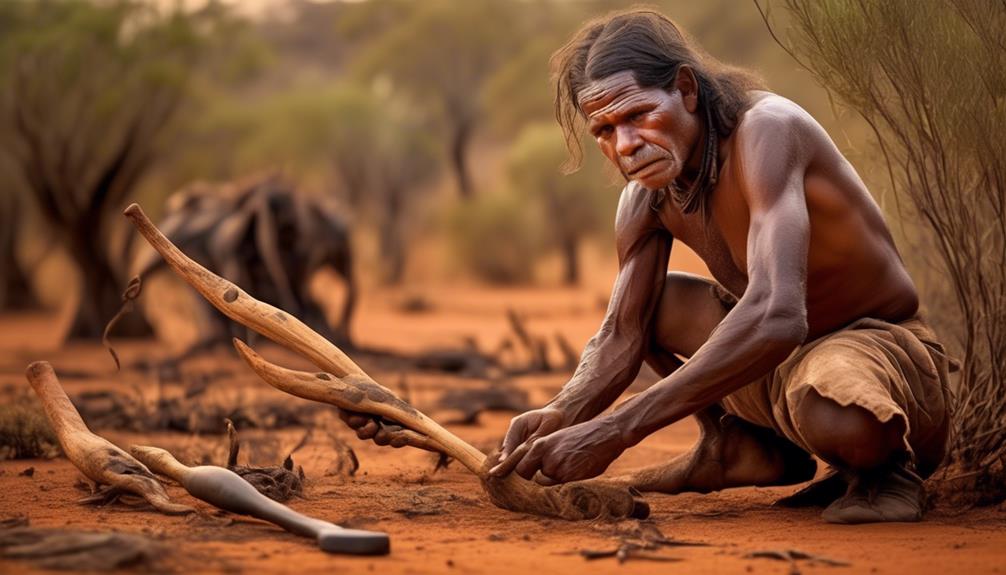
Navigating the challenges of the modern world, our community has demonstrated remarkable resilience and adaptability in preserving our cultural heritage and traditions. Our survival and adaptation have been driven by a deep connection to the land and a rich tapestry of adaptation strategies and survival techniques that have been passed down through generations. We have embraced change while holding onto the essence of our identity, finding innovative ways to blend tradition with modernity.
| Adaptation Strategies | Survival Techniques |
|---|---|
| Embracing technology | Bushcraft skills |
| Education | Sustainable resource use |
| Cultural revitalization | Community support networks |
Embracing technology has allowed us to share our stories, art, and traditions with a global audience, preserving our cultural heritage in the digital age. Education has played a pivotal role in equipping our youth with the skills needed to navigate the complexities of the modern world while maintaining a strong connection to our roots. Through cultural revitalization efforts, we have reinvigorated traditional practices, ensuring that they remain relevant and thriving.
Our adaptation strategies have been complemented by survival techniques rooted in our deep understanding of the land. Bushcraft skills have been essential in ensuring our ability to thrive in diverse environments, while sustainable resource use has allowed us to maintain a delicate balance with nature. Additionally, community support networks have provided a safety net, fostering a sense of unity and collective resilience in the face of adversity. As we continue to adapt and evolve, our cultural inheritance remains the cornerstone of our identity, guiding us through the complexities of the modern world.
Impact of Colonization
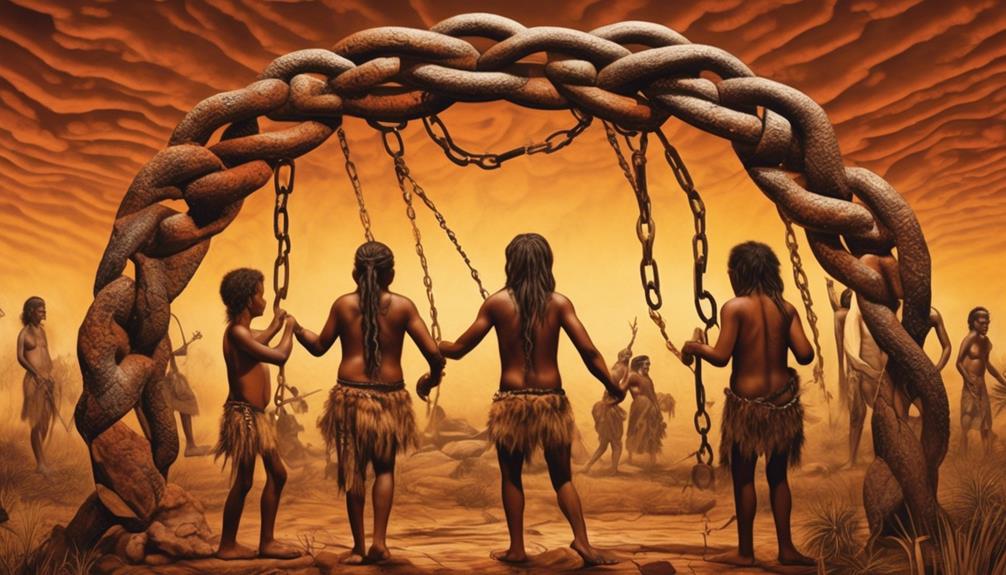
The lasting impact of colonization on our community is a complex and deeply ingrained aspect of our history, shaping our experiences and challenging the preservation of our cultural heritage. The impact of colonization has been profound, and its effects continue to reverberate through our community, influencing our social, economic, and cultural realities.
Some of the key ways in which colonization has impacted our community include:
- Loss of Land and Sovereignty: The dispossession of our ancestral lands and the erosion of our sovereignty have had a profound impact on our cultural resilience. The connection to the land is fundamental to our identity and well-being, and the loss of this connection has been deeply traumatic.
- Cultural Disruption and Suppression: The imposition of colonial policies and practices has resulted in the disruption and suppression of our traditional cultural practices, languages, and knowledge systems. This has had a detrimental impact on our ability to maintain and transmit our cultural heritage to future generations.
- Historical Trauma and Intergenerational Effects: The legacy of colonization has resulted in historical trauma that continues to affect our community. The intergenerational transmission of trauma has had a significant impact on the health and well-being of our people, contributing to social issues such as substance abuse, mental health challenges, and family breakdowns.
Navigating the impact of colonization while striving to preserve and revitalize our cultural heritage is an ongoing journey that requires acknowledgment, healing, and empowerment.
Stolen Generations
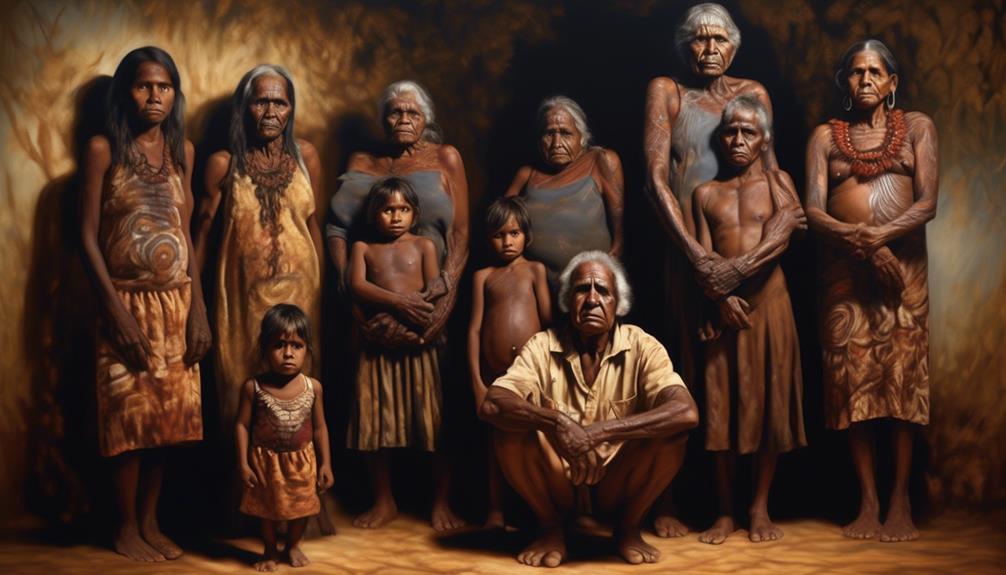
As we explore the impact of colonization on Australian Aboriginal communities, it's crucial to acknowledge the profound and enduring effects of the Stolen Generations.
The historical trauma inflicted by the forced removal of Indigenous children from their families continues to reverberate through generations, shaping the experiences and perspectives of Aboriginal people today.
Moreover, recognizing the ongoing efforts for intergenerational healing and reconciliation is essential in understanding the complexities of this deeply painful chapter in Australian history.
Historical Trauma Impact
Experiencing the historical trauma impact of the Stolen Generations has significantly shaped the Australian Aboriginal community's narrative and continues to affect generations today. The mental health of individuals and the community has been deeply impacted, leading to intergenerational trauma. However, healing and resilience are evident as the community actively seeks to address these challenges.
- Healing and Resilience: Through cultural revitalization and reclaiming traditional practices, the community fosters healing and resilience.
- Mental Health: Addressing the mental health impacts of historical trauma is crucial for the well-being of individuals and the community.
- Community Support: Building strong support networks and community-led initiatives plays a vital role in addressing the ongoing impact of historical trauma.
The journey towards healing and empowerment requires acknowledging the historical trauma impact while also celebrating the strength and resilience of the Australian Aboriginal community.
Intergenerational Healing Efforts
Shaped by the lasting impact of the Stolen Generations, our community actively engages in intergenerational healing efforts to address the deep-seated trauma and foster resilience for future generations.
Healing practices rooted in cultural traditions and community support play a pivotal role in our journey toward overcoming intergenerational trauma. We embrace a holistic approach, integrating both contemporary and traditional healing methods to honor our cultural resilience.
Through storytelling, art, and connection to the land, we seek to mend the wounds of the past and fortify the spirit of our people.
The intergenerational trauma inflicted by historical injustices necessitates a concerted effort to heal and empower our community. By nurturing a supportive environment and reclaiming our heritage, we strive to instill hope and strength in the hearts of our descendants, ensuring a legacy of resilience and cultural pride.
Land Rights and Connection

The deep spiritual and cultural connection that Australian Aboriginal people have to their land is integral to their identity and way of life. This connection goes beyond mere ownership; it's rooted in the very essence of our being. Our ancestors have passed down stories, traditions, and rituals that are intricately woven into the land. This connection is vital for our cultural preservation, and it shapes our understanding of the world around us.
- Land Ownership: The concept of land ownership in Aboriginal culture isn't about possessing the land, but rather being a custodian of it. The land is considered a living entity, and our responsibility is to care for it and ensure its well-being for future generations.
- Spiritual Connection: Our spiritual beliefs are deeply tied to the land. It's where the stories of our ancestors reside, where our rituals are performed, and where we find solace and connection to our spiritual beings.
- Historical Injustices: The struggle for land rights has been marred by historical injustices, including dispossession, forced removal from traditional lands, and the lack of recognition of our connection to the land. These injustices have had a profound impact on our communities.
The fight for land rights is ongoing, and it isn't just a legal battle; it's a fight for our cultural survival. It's essential for the broader community to acknowledge and respect our connection to the land, and to work towards reconciliation and healing.
Contemporary Challenges
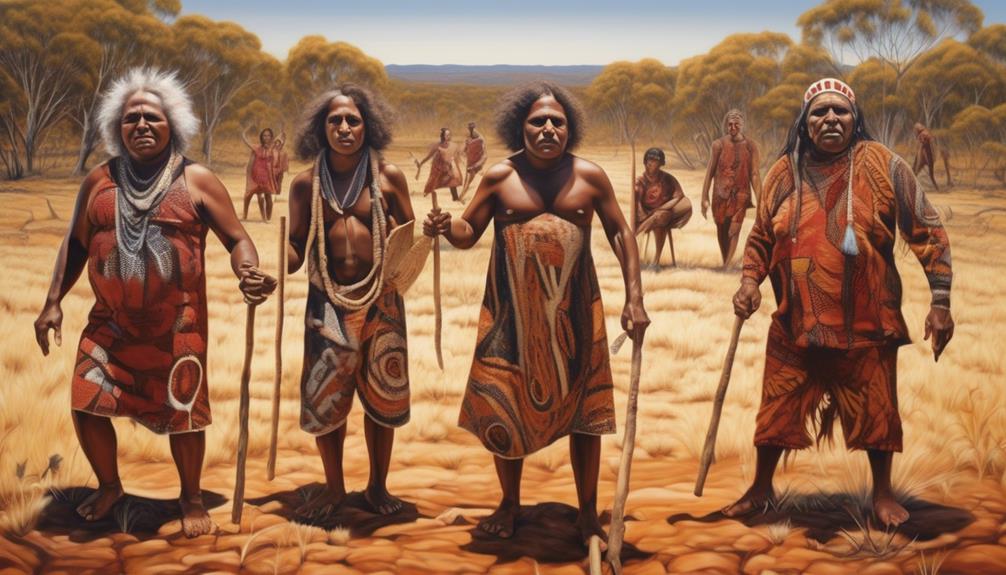
Addressing the legacy of historical injustices, the contemporary challenges faced by Australian Aboriginal communities in preserving their cultural connection to the land continue to present complex and ongoing struggles. The impact of modernization has significantly altered the traditional landscapes that hold immense cultural and spiritual significance for Aboriginal people. Rapid urbanization, industrial development, and resource extraction have encroached upon sacred sites, disrupting the delicate balance between the Indigenous communities and their ancestral lands. These challenges are further compounded by the ongoing struggles for land rights and self-determination, as Aboriginal people continue to fight for recognition of their inherent connection to the land.
Moreover, the process of cultural preservation is intricately linked to the identity struggles experienced by Aboriginal communities. The erosion of language, customs, and traditional knowledge due to colonization and forced assimilation has created a profound disconnect between the younger generations and their cultural heritage. This loss of cultural identity has far-reaching implications for the well-being and resilience of Aboriginal communities, as it impacts their sense of belonging, social cohesion, and mental health.
In navigating these contemporary challenges, it's imperative to recognize the agency and resilience of Aboriginal communities in reclaiming and revitalizing their cultural practices, languages, and spiritual connections to the land. Collaborative efforts that center Indigenous knowledge and self-determination are essential in addressing the complex interplay of historical injustices, modernization, and identity struggles faced by Australian Aboriginal communities.
Revival of Language and Culture

Striving to reclaim and preserve our ancestral language and cultural traditions has become a paramount endeavor for Australian Aboriginal communities in our ongoing journey towards cultural revitalization and resilience. Revival efforts are gaining momentum as we recognize the integral role language preservation and cultural reclamation play in our identity and well-being.
The resurgence of traditional practices is a testament to our unwavering commitment to honoring our heritage and passing it on to future generations.
- Language Preservation: Intergenerational transmission of our native languages is pivotal to our cultural survival. Efforts to document and revitalize endangered languages are underway, ensuring that our linguistic heritage remains a vibrant and integral part of our community.
- Cultural Reclamation: Rediscovering and celebrating our traditional art forms, storytelling, and ceremonies is central to our cultural reclamation journey. By embracing our customs and practices, we're fostering a renewed sense of pride and connection to our roots.
- Revival Initiatives: Collaborative initiatives within our communities and with external partners are propelling the revival of our language and culture. Through educational programs, community events, and digital platforms, we're actively engaging in the revitalization of our rich heritage.
The revival of language and culture serves as a beacon of hope, empowering us to navigate the complexities of the modern world while staying grounded in our ancestral wisdom. As we continue on this path of revival, we're cultivating a legacy of resilience and cultural vibrancy for generations to come.
Cultural Festivals and Ceremonies
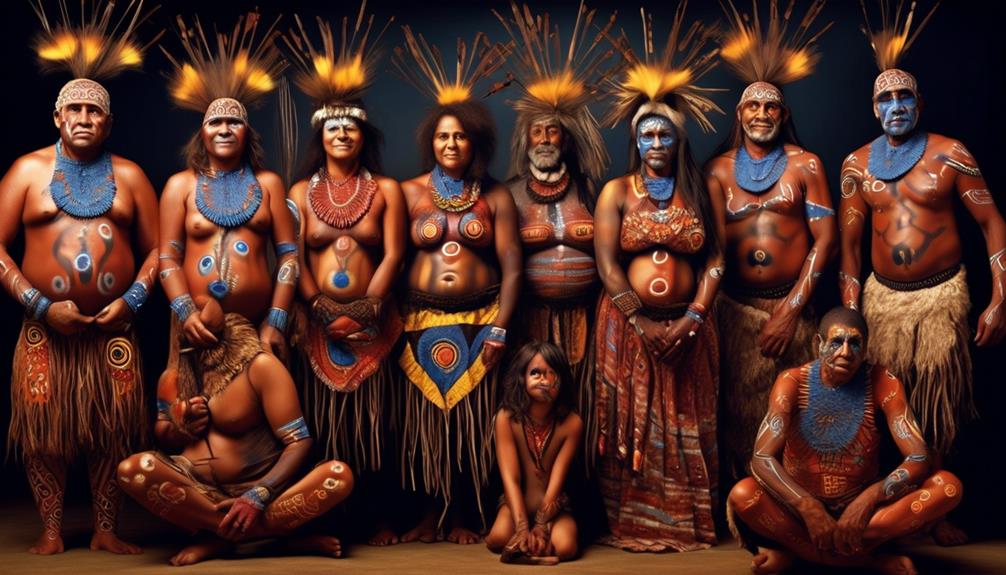
Embracing our cultural revival journey, we enliven our traditions through vibrant cultural festivals and sacred ceremonies that serve as cherished expressions of our ancestral heritage. Cultural festivals and ceremonies play a pivotal role in our cultural preservation, allowing us to pass down our traditions, stories, and knowledge to the next generation. These events are not only an affirmation of our identity but also an opportunity for community participation, fostering a sense of unity and belonging.
| Cultural Festivals | Sacred Ceremonies |
|---|---|
| – Corroborees | – Initiation Ceremonies |
| – Tjungu Festival | – Smoking Ceremonies |
| – Garma Festival | – Dreaming Ceremonies |
Cultural festivals, such as the Tjungu Festival and the Garma Festival, are platforms for showcasing our art, music, dance, and traditional performances. These events are open to all, allowing people from different backgrounds to come together, learn about our culture, and celebrate our heritage. On the other hand, sacred ceremonies, including initiation, smoking, and Dreaming ceremonies, are deeply rooted in spirituality and are essential for maintaining our cultural practices and beliefs.
Through these festivals and ceremonies, we invite individuals from all walks of life to engage in our cultural traditions, fostering a greater understanding and appreciation of our heritage. This active participation from the wider community not only enriches our cultural experiences but also strengthens our collective identity and sense of belonging.
Contributions to Science and Knowledge
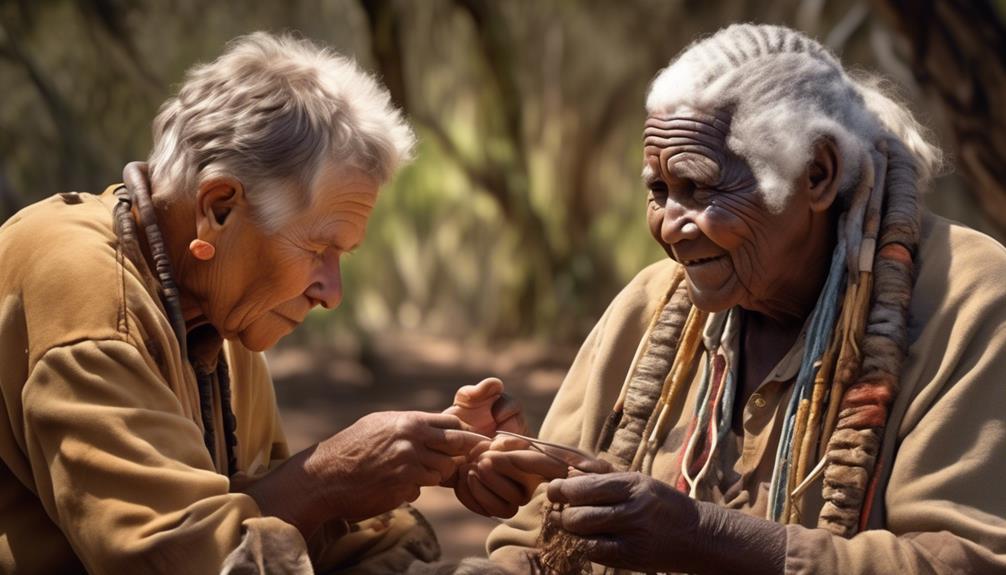
With a legacy deeply intertwined with the land and its natural rhythms, our Aboriginal culture has made substantial contributions to science and knowledge, enriching the world's understanding of ecology, astronomy, and sustainable living practices. The wealth of Indigenous knowledge has significantly advanced scientific understanding in various fields, fostering a deeper appreciation for the intricate connections between nature and humanity.
- Scientific Achievements
Aboriginal knowledge systems have contributed to scientific achievements in understanding ecological patterns, plant properties, and animal behavior. Traditional ecological knowledge, accumulated over millennia, has provided valuable insights into sustainable land management, biodiversity conservation, and the medicinal properties of native flora.
- Indigenous Knowledge Preservation
Our culture has played a pivotal role in preserving Indigenous knowledge, ensuring its continuity for future generations. Through oral traditions, storytelling, and experiential learning, our communities have safeguarded valuable scientific knowledge, passing it down through generations to maintain its relevance and applicability in contemporary contexts.
- Environmental Stewardship
The Aboriginal approach to sustainable living practices and environmental stewardship has offered profound lessons for modern scientific endeavors. By observing natural cycles, weather patterns, and celestial movements, our culture has enriched the field of astronomy, contributing to a holistic understanding of the cosmos and the interconnectedness of all life on Earth.
The contributions of our Aboriginal culture to science and knowledge underscore the importance of embracing diverse perspectives and traditional wisdom in the pursuit of a harmonious relationship with the natural world.
Representation in Media and Arts
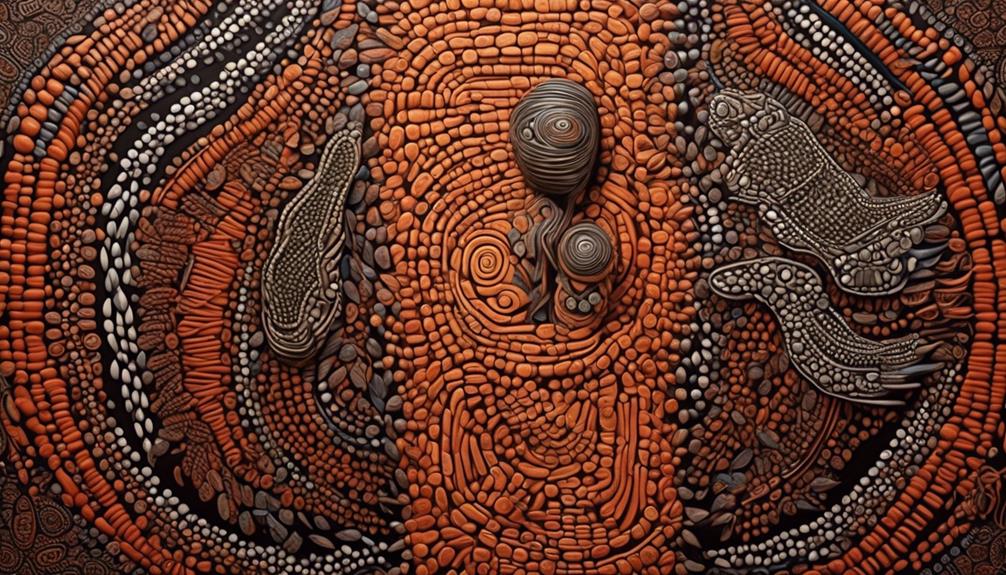
Australian Aboriginal culture has been increasingly gaining recognition and representation in various forms of media and arts, reflecting the rich diversity and traditions of our heritage. Media representation plays a crucial role in shaping societal perceptions and attitudes towards Aboriginal communities.
The portrayal of our culture in mainstream media has historically been riddled with stereotypes and misrepresentation. However, there's been a positive shift in recent years, with increased efforts to provide more authentic and respectful depictions of Australian Aboriginal people in the media. This has allowed for a more accurate representation of our traditions, values, and contemporary issues, breaking away from the narrow and often demeaning narratives that have dominated the past.
Artistic expression has also been a powerful tool for Australian Aboriginal people to reclaim their narratives and showcase the depth of our cultural heritage. Through various art forms such as painting, storytelling, music, and dance, we've been able to communicate our lived experiences, challenges, and triumphs to a global audience. This hasn't only fostered a greater understanding and appreciation for our culture but has also provided a platform for Aboriginal artists to thrive and gain recognition for their contributions to the arts.
Future Prospects and Resilience
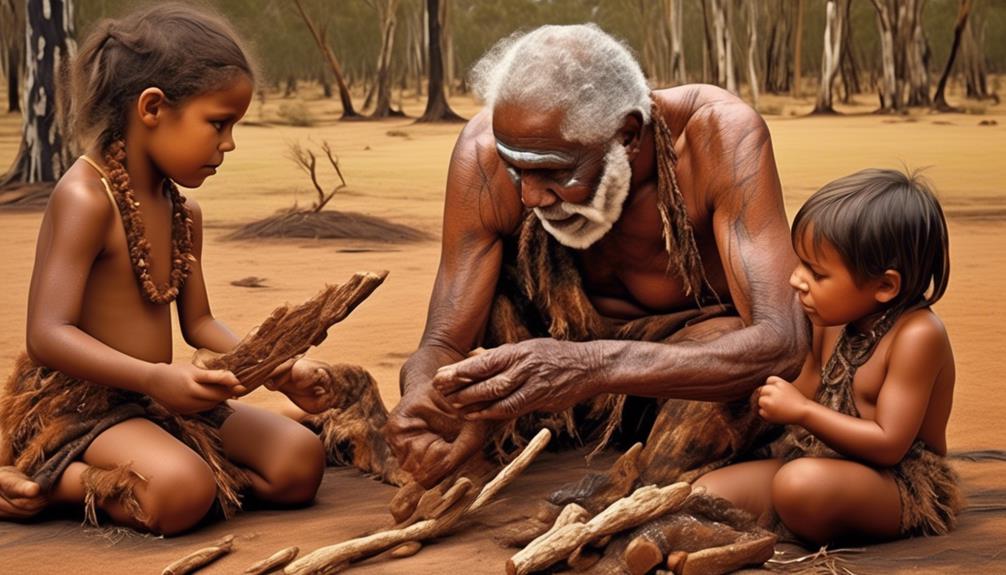
Building on the progress made in media and arts representation, the Australian Aboriginal community continues to demonstrate resilience and focus on future prospects. It's a testament to our strength and determination that despite the historical challenges, we're actively shaping our future.
- Community Empowerment: Our community is actively engaging in initiatives that empower individuals and strengthen our collective identity. Through cultural revitalization efforts and community-led programs, we're fostering a sense of pride and unity. This empowerment is crucial in overcoming systemic barriers and creating a more equitable society.
- Educational Opportunities: Access to quality education is fundamental for our community's advancement. Efforts to improve educational opportunities for Aboriginal youth are underway, aiming to provide the necessary tools for success and to empower future generations to pursue their dreams.
- Economic Development and Environmental Sustainability: We're committed to fostering economic development while ensuring environmental sustainability. By leveraging our unique cultural heritage and promoting sustainable practices, we're creating opportunities for economic growth that align with our values and respect for the land.
As we continue to navigate the complexities of the modern world, our resilience remains unwavering. By focusing on community empowerment, educational opportunities, economic development, and environmental sustainability, we're actively shaping a future that honors our heritage while embracing the possibilities of tomorrow.
Frequently Asked Questions
How Do Australian Aboriginal Communities View the Role of Women in Traditional Society?
In many traditional societies, the role of women is deeply respected and valued. They often play crucial roles in maintaining cultural traditions and passing down knowledge of traditional healing practices.
Women are often entrusted with the responsibility of preserving and transmitting cultural wisdom, ensuring the continuity of their community's heritage. Their contributions are integral to the wellbeing and sustainability of their traditional societies.
What Are Some Traditional Healing Practices Used by Australian Aboriginal People?
Traditional healing practices used by various cultures include:
- Herbal remedies
- Energy work
- Spiritual ceremonies
These practices often emphasize the importance of maintaining a holistic balance between the mind, body, and spirit. They're deeply rooted in a spiritual connection to nature and the universe, aiming to restore harmony and well-being.
Such healing methods, passed down through generations, showcase the profound wisdom and resilience of indigenous communities.
How Do Australian Aboriginal Communities Address Mental Health Challenges Within Their Population?
In addressing mental health challenges, communities provide mental health support through various programs and services. Additionally, cultural healing practices are integrated, recognizing the importance of holistic approaches to well-being.
These practices emphasize the interconnectedness of mental, emotional, and spiritual health. By combining traditional healing methods with modern interventions, communities strive to create a supportive environment that respects cultural values and promotes mental well-being.
What Are Some Lesser-Known Cultural Practices or Traditions of Australian Aboriginal People?
In many cultures, traditional food and artistic expression play significant roles. These practices often hold deep symbolic and spiritual meanings for the community.
Similarly, within Australian Aboriginal culture, traditional food and artistic expression are central to preserving and passing down cultural knowledge. These lesser-known practices reflect a rich heritage and provide insight into the deep connections between the people and their land.
How Do Australian Aboriginal Communities Perceive the Concept of Time and History?
In our perception, the concept of time and history is deeply rooted in Dreamtime beliefs and oral storytelling. These traditions have been crucial in preserving our cultural identity and passing down knowledge through generations.
However, the impact of colonization has greatly influenced and altered our understanding of time and history. It's important to recognize the complexities and nuances in how different communities perceive and navigate these concepts.
Conclusion
In conclusion, the rich and diverse culture of Australian Aboriginal people continues to thrive and evolve, contributing to the tapestry of human experience.
Their deep connection to the land, intricate social structures, and vibrant artistic expressions offer valuable insights and inspiration to the world.
By acknowledging and celebrating their contributions, we can honor their resilience and ensure their voices are heard in shaping a more inclusive and understanding future for all.
Talise is a talented writer and an expert in her field. Her unique perspective and insights enrich our content with depth and authenticity. With a wealth of knowledge and a strong connection to the subjects she writes about, Talise crafts engaging and informative articles that resonate with our readers. Her dedication to bringing Indigenous culture and wisdom to light is truly commendable.
